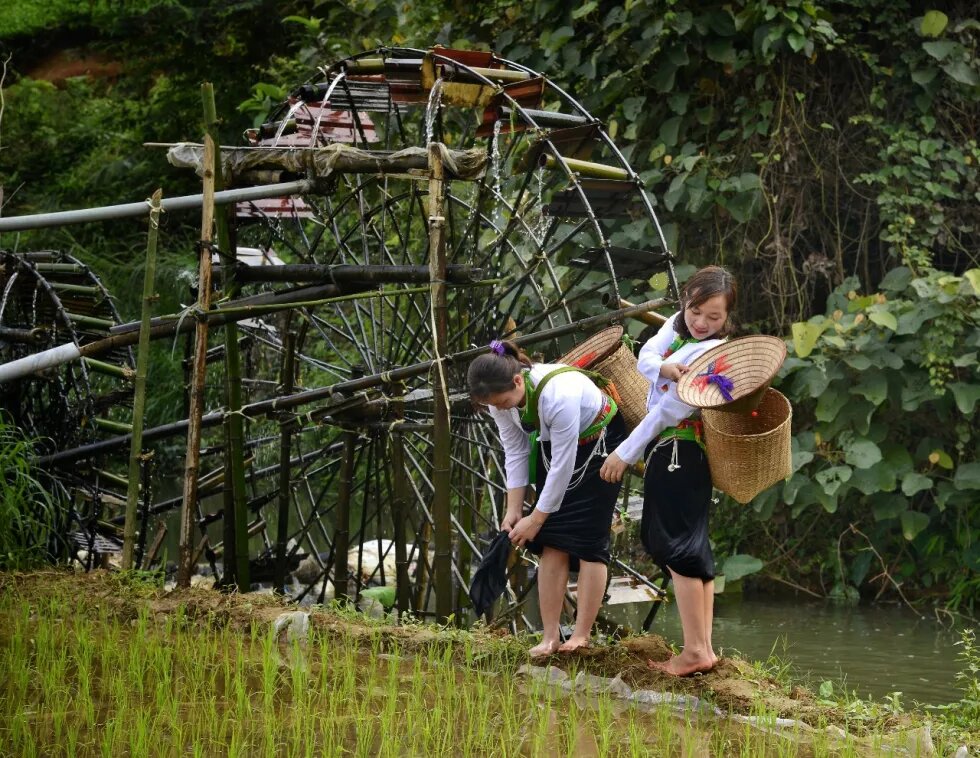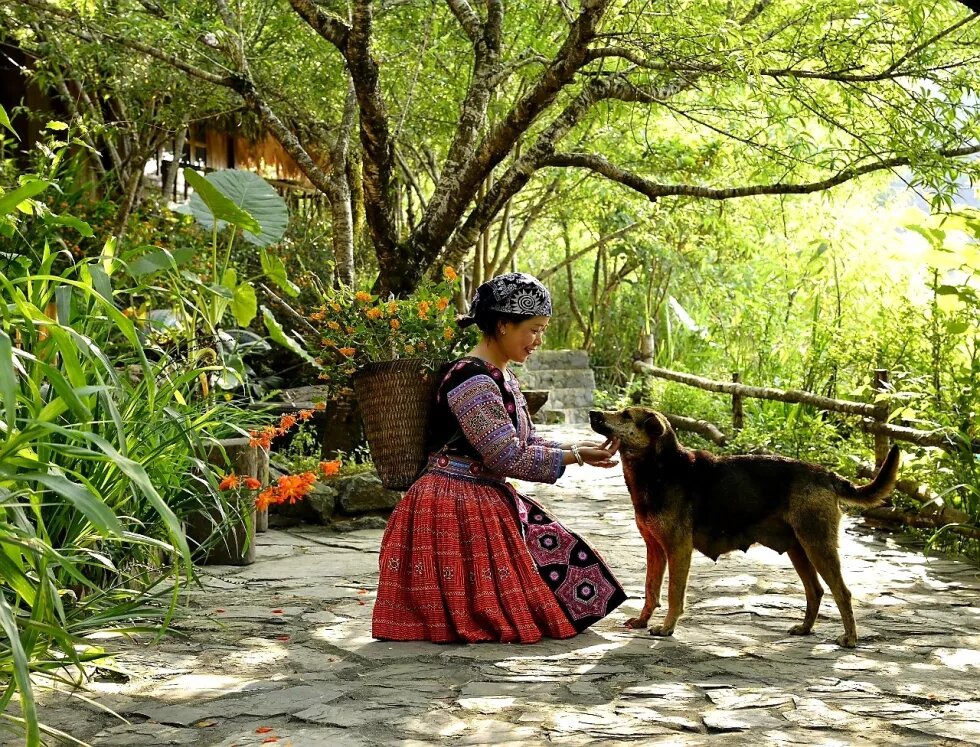
Ethnic women in northwest Vietnam possess knowledge about forest biodiversity. Still, they are facing challenges from language barriers and state policies in sharing and disseminating their valuable knowledge to the next generations.

Bình said she usually has free time on the weekend, yet, on a Sunday afternoon, the 52-year-old farmer from the ethnic Yao community in Lao Cai in northwest Vietnam could not find time to rest. Bình had spent the entire morning with her daughter picking about 20 kilograms of colorful leaves from the forest that they were now slicing and sorting for her family’s medicinal use and for sale.
“Three generations of my family have survived on these leaves”, said Bình, who struggled to speak in Vietnamese and had to turn to her children for help with translation. “Without these leaves to help us, we would not have survived.”
Bình said the leaves consist of four groups for medicinal uses: to treat flu, to cure injuries, to help hair growth, and as painkillers to alleviate pain. Bình did not know the leaves’ names in Vietnamese, only in her native Yao language, but she could not read or write in either language.
“Only my brothers were taught by my father and grandfather to read and write in Yao, not me and my sisters,” she said.
The ethnic Yao or Dao community in Vietnam are one of the minority ethnic groups in Vietnam; the majority group is the ethnic Kinh (Việt), who make up around 85% of the population, while the remaining 15% is composed of 53 other ethnic minority groups including the Yao.
Bình, like many women from other ethnic groups in Lao Cai province, such as Hmong and Tay, has extensive knowledge of the local flora and fauna, having lived in, and depended on, the forest her entire life. However, her language constraints make it difficult for her and others with similar constraints to pass on their knowledge to their children or share it with others. Many ethnic languages are not formally taught and usually find no takers among young learners who prefer to use the majority Vietnamese language. This makes it a huge challenge to preserve and transmit their traditional knowledge about the forest to future generations.
Biodiversity in Lào Cai: limited research, untapped wisdom
Bình, like many of her peers, accompanied her parents to the forest when she was just four years old. Her late father taught her to identify different leaves, observe plants and trees in different seasons, and memorize their medical properties. Her parents, and now her own family, continue to take seriously the annual forest worshipping ceremony on the 2nd of February (according to the lunar calendar).
According to ethnic beliefs, this ritual ceremony is performed to ask for the protection of the forest spirits, to provide shelter for the entire village for a year of favorable weather and abundant harvest, for the livestock to be strong, and for every household to be safe and healthy. The ritual is also an opportunity to raise awareness about protecting the forests.
At the end of the ceremony, the elders in the village will pass down the responsibility of conserving the forest to the next generation. The medicinal plants will be sorted and combined to create health remedies that have been used by the Yao people for a long time. For these medicinal resources to be preserved, the conservation of forest biodiversity is critical.
When she got older, Bình paid a senior Yao teacher to learn how to make a living by selling herbal plants. However, Bình noted that her teacher was not always willing to share her knowledge with her disciples.
“No teacher would tell you about all the types of trees and leaves that they might know. They keep this as a secret within each family in this region,” said Bình.
Chan Mẩy, a 19-year-old entrepreneur now working on a project to promote local natural products, experienced a lack of opportunities to learn her Yao language and culture due to gender stereotypes by which the language is taught mainly to males. She does not know how to read the Yao language, just like her mother, grandmother, and mother-in-law.
“Most Dao women don’t know how to read because our community only values men being literate. I couldn’t study, so I don’t know how to read either,” she said.
An ecologist based in Vietnam, who prefers to remain anonymous, stated that the biodiversity in Lào Cai is shrouded in mystery due to limited opportunities for researchers both locally and internationally to conduct fieldwork. One of the primary challenges researchers face is the difficulty in communicating with ethnic communities, which is compounded by language barriers and other factors. Often, researchers do not know ethnic languages, while women who know about the forest biodiversity receive limited schooling and generally possess a poor command of the Vietnamese language, making communications between researchers and ethnic communities quite difficult. High-quality translators are sorely lacking.
The establishment of the Indigenous Knowledge Development Program, known in Vietnamese as tri thức bản địa in 1998 emphasized a more structured inclusion of ethnic and indigenous knowledge in social development. In Vietnam, local or ethnic knowledge refers to the activities of the country’s many ethnic minority communities other than the majority Kinh. While the government emphasizes preserving indigenous and ethnic cultures and customs, making use of indigenous knowledge is not highlighted. Ethnic minorities are also often portrayed in mainstream media as backward and lazy.
Research has shown that the knowledge of biodiversity held by ethnic communities is being lost at a quick pace. It is mainly the elders who are holding on to and using this knowledge in ethnic minority communities. Younger people, by and large, express little interest in conserving traditional knowledge and skills, and tend to be more interested in scientific knowledge and modern technologies.
Challenges in learning ethnic languages
While Bình is aware that her lack of language skills has hindered her business opportunities, investing time and energy in learning to read and write in either Yao or Vietnamese is for her unlikely. “I am too old to start now. And too slow too,” she said. “When can I find the time to study now? You see, I do not have time to breathe.”
The country’s language policy allows for the use of ethnic languages. Article five of the Constitution reads, “The national language is Vietnamese. Every ethnic group has the right to use its own language and system of writing to preserve its national identity, and to promote its fine customs, habits, traditions, and culture.” However, there is a mismatch between the law and reality.
Despite declarations of policy support for minority languages, these policies are rarely implemented. The government has emphasized that diversity should not compromise national unity, which is believed to be achieved through the mastery of the Vietnamese language by all citizens. However, as Vietnamese is the only language of instruction in public education, minority students often face challenges as they have to learn all subjects in Vietnamese.
Although the Education Law stipulates that the state shall create opportunities for minority students to learn their mother tongues few schools in minority-concentrated regions have fully implemented this legal obligation. Only a handful of primary schools offer minority language as a subject, rather than a medium of instruction.
Even when beyond school Yao language classes are available, students face other less visible challenges to attend such as being discouraged by teachers from attending after-school classes.
Language transmission through the family
Language transmission within the family and community is a major factor in preserving ethnic languages.
“There are not enough teachers,” said Tần Sìu, who is one of the few Yao language teachers in this region.
But Yao youths are now taking action. Bình’s son tries to jot down what her mother teaches him, though he has also struggled to translate names from spoken Yao language into written Vietnamese.
Entrepreneur Chan Mẩy is dedicated to preserving the valuable knowledge about the forest of her mother and grandmother. She knows this knowledge can be valuable for using these forest products for herbal cosmetics and health products that can be sold both domestically and internationally.
“I noted down what I learned in Vietnamese, and my goal is to document this knowledge for the younger generation,” she said.
Teacher Sìu, who has been creating his own Yao reading textbooks, said his Yao language classroom is open all year round to everyone.
“Many women are learning their own language,” said Siu. “It is hard to conserve the forest if people know nothing about it.”
__
This article first published by Mekong Commons on 7 July 2023, as part of the output of "Mekong Commons Online Writeshop" supported by Heinrich-Böll-Stiftung Southeast Asia regional office.
Vu Hong Trang is a social entrepreneur from Vietnam and gender advisor at Equal Asia Foundation.
The views expressed in this article are not necessarily those of Heinrich Böll Stiftung.

